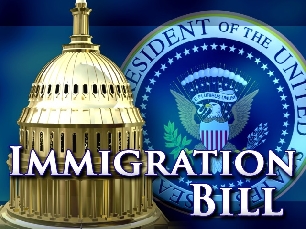Learn More About:
Immigration News & Updates eNewsletter © 2011 - 2021
For questions about U.S. Residency, Green Cards and Immigration Visas, Visit our Website at: www.ImmigrateToday.com or call our office at: (954) 382-5378
Check Out This Cool Stuff For Immigrants....
Immigration
Questions & Answers
This Week's Immigration News
Immigration News & Updates
Immigration How To:
How Do I Know What Documents I Need For My Consular Immigrant Visa Process?
Questions About Immigration? We have the answers!
We Are Here To Help, Call us now for a FREE consultation (954) 382-5378
US Citizenship Act of 2021 Pending In Congress - Here’s A Few Tips On Getting Ready For Immigration Reform
AMERICAN IMMIGRATION
LAW CENTERS
Immigration Questions: (954) 382-5378
POSTING DATE: March 1, 2021
Question: I have a question about getting my citizenship. My husband, a citizen and I got married in 2017. We went to my interview in 2018 but had to have a second interview which took another 9 months, so I didn’t actually get my green card until april 2019. Me and my husband will be married for 4 years coming up in may and I want to apply for my citizenship. Do I just need to show our marriage certificate to be eligible?
USCIS Announces Reinstatement of 2008 Citizenship Test
American Immigration
Law Center
2645 Executive Park Drive
Suite 137
Weston, Florida 33331
As expected, last week the USCIS announced that it will reinstate the 2008 pre-Trump version of the U.S. Citizenship Civics test beginning March 1st. The USCIS notice states that it will revert back to the 2008 version of the civics test because it had determined that the 2020 civics test “content, testing procedures, and implementation schedule may inadvertently create potential barriers to the naturalization process.”
In other words, Trump and his administration devised the new test as a barrier to prevent residents from becoming U.S. citizens, and the Biden administration wants to reverse that and make it easier in order to encourage more naturalization!
Now that President Biden’s long awaited immigration reform bill has been introduced in Congress, experts are already predicting an uphill battle to get it approved. And as expected, one of the most popular and controversial provisions of the measure, proposes to legalize millions of immigrants who were present in the U.S. on or before January 1, 2021 (with some exceptions) and who either entered the U.S. illegally (without authorization), or entered legally, but fell out of legal status.
This includes all those who applied for, but have not yet been granted asylum, immigrants in removal proceedings and those with final orders of deportation. It will likely also apply to those who entered the U.S. on crewmen C/D visas, as well as J visa holders subject to the 2-yr foreign residency requirement.
Helpful Immigration Tips You Can Use...
Many Work Permits Are Automatically Extended For Six Month Past Expiration
A little known policy, called the Automatic Employment Authorization Document (EAD) Extension rule allows pending residency and other immigrants with expiring work permits to keep working for six months. Under the rule, eligible applicants in certain immigration categories with expiring work permits who have filed for extensions (form I-765), are automatically authorized to continue working for an additional six month period while waiting for the renewal to be issued. This comes in very handy now that the normal processing time for work permit renewals takes six months and is likely to exceed that during and post pandemic. Eligibility is limited to certain immigration categories, including those for pending adjustment of status applicants, called C(9).
Tips On Successfully Surviving The National Visa Center Process
The family immigration process often takes many, many years waiting in line and then finally once an Immigrant Visa becomes available, the National Visa Center (NVC) and U.S. Consulate begin final processing for your relative, ending in the immigrant visa consular interview appointment and thereafter immigrating to the U.S.. But even after waiting all those years, the final processing steps themselves can be very intimidating and stressful.
There are also a lot of grey areas which could affect the eligibility of thousands of immigrants, for instance those who were granted non-immigrant visa status, for example an H-1B work visa, but who lost their job and were unable to continue working for the sponsoring employer as required. The same is true of F-1 students who were unable to continue to attend school and had to drop out. In these types of cases, it may be possible to prove that although an immigrant’s non-immigrant visa is still valid, they were not maintaining legal status in the U.S. on January 1, 2021, however, the bill does not specifically address these issues.
Should the US Citizenship Act of 2021 be approved by Congress and become a law, most immigrants who were inside the U.S. on January 1, 2021 will be eligible to apply for “Lawful Prospective Immigrant” LPI status, which would provide work and travel authorization and the right to live in the U.S. legally for six years and to apply for a green card after five years. After holding a green card for three years, these residents could then apply for U.S. Citizenship. Legalization programs in the past have commonly been referred to as an “amnesty”, which means an official pardon for immigration status violations. As a result, once Congress starts to take action on the immigration bills, you will likely see and read a lot in the news about the amnesty, which will simply be referring to the “Lawful Prospective Immigrant” LPI status proposed in the bill. It is important to note that the immigration proposal has a long way to go before it becomes law, and there is no guarantee that it actually will. However, immigration reform is much more likely now, than it was in the past, so it is never too early to start getting prepared.
Tips On Preparing For Immigration Reform –
Gathering & Organizing Your Documents!
If the amnesty provisions do become law, one of most important things immigrants need to do is to prove eligibility. Proving eligibility requires submitting documentary proof that the Immigrant has been living inside the U.S. continuously for a certain period of time and has continued to be physically present in the U.S. up until the date the Immigration program is enacted. This can often be a very tough challenge since most Immigrants who lack legal status are often not able to obtain Driver’s Licenses, open bank accounts and easily create a record of living and working in the U.S.. However, as difficult as it seems, evidence will be required and those who are not able to provide it will have a hard time qualifying for legal status. The USCIS does not simply accept an Immigrants “word” that they have been inside the U.S. during the required period – they have to prove it!
Those with bank accounts, utility bills and paystubs and U.S. birth certificates for children born in the U.S. will find it easy to qualify, but those without bank accounts and utilities or evidence of employment will need to find other creative means to document their life in the U.S.. This requires some effort to come up with evidence to cover certain periods of time, for instance, the USCIS will accept evidence such as copies of lease/rental receipts, cell phone bills, gym or other memberships, installment payments, automobile insurance, health insurance, automobile registration, school transcripts, hospital/medical & vaccination records, religious memberships, etc.
The best approach is to start now both getting your past and current documentation together and keep accumulating new ones up until the day the program is implemented. It is also important to provide evidence of the date you entered the U.S. Those who entered the U.S. legally and have a copy of their passport with entry stamp and I-94 card will have an easy time of it. However, those who entered illegally will have a tougher time and will need to rely on other documents mentioned above to prove the date they began living in the U.S.. Immigrants who have lost their passport with the legal visa and entry stamp who remember their date of entry can usually obtain a duplicate I-94 from the USCIS to prove date of entry by filing form I-102 and paying the $445 fee. Note that it can take many months to receive the new I-94, so it is best not to wait until the last moment.
You can contact us to receive a free list of documents to begin organizing
in anticipation of an upcoming amnesty by calling (954) 382-5378.
Those who filed naturalization applications from December 1, 2020 and February 28, 2021 will not be forced to take the Trump test, but instead will be given a choice as to which test they wish to take. The USCIS has also scheduled a Webinar on Wednesday, March 3, 2021, from 3:30 to 4:30 p.m. Eastern and invites the public to attend. The webinar will provide an overview of the both the 2008 and 2020 versions of the naturalization civics test, including the different features of each test and experts will share an overview of online test preparation materials and educator resources and provide a question-and-answer session.
President Biden Terminates Trump’s Proclamation Which Banned Immigrants From Obtaining Visas At US Consulates Abroad
Last week on February 24, 2021, President Biden issued a Proclamation revoking Trump’s ban on visa issuance. For background, on April 22, 20202, Trump issued a Proclamation (called Suspension of Entry of Immigrants Who Present a Risk to the United States Labor Market During the Economic Recovery Following the 2019 Novel Coronavirus Outbreak) which imposed a ban on the issuance of visas to immigrants at U.S. Consulates abroad.
The ban was extended by a subsequent Proclamation issued by Trump on June 22, 2020, which effectively brought nearly all visa issuance at U.S. Consulates worldwide to families and foreign workers (including H-1B, H-2B, L-1, J-1, H-4, L-2, and J-2 visas) to a standstill.
Under the new Proclamation, U.S. Consulates worldwide will now resume processing of immigrant and non-immigrant visas in accordance with each location’s Covid-19 operational safety procedures. Realistically, due to the pandemic, most consulates are not in full operations, are operating with reduced staffing and will slowly begin scheduling immigrant interviews according to country conditions. However, this is a great step in the right direction and hopeful sign that aside from the pandemic, the U.S. is back in the immigration and visa issuance business!
Read President Biden Proclamation revoking Trump’s ban on visa issuance
Answer: Eligibility to file for naturalization is not based solely upon how long you have been married to a U.S. Citizen, instead, it is based upon how long you have been a U.S. Resident. The rule is that a U.S. Resident (conditional or permanent) who is married and living together in a real marriage with his or her U.S. Citizen spouse, can apply for early naturalization once they have held residency status for two years and nine months. This is true even if the Removal of Condition petition remains pending. In these cases, USCIS policy says the officer should adjudicate the Removal of Condition application for permanent residency along with the early naturalization application at the same time. This can theoretically speed up a pending Removal of Condition case. In your case, since you obtained your green card in April 2019, you can apply three months before your third year residency anniversary in April 2022, so January 2022. I hope this is helpful to you.
Question: Me and my girlfriend have been in a long distance relationship since 2019. I came to visit her in september and only planned to stay a few weeks, but ended up changing my return flight from october 2020 to this march 2021. I am scheduled to go back next week before my status expires on march 14th. We don’t want to be apart anymore and are talking about getting married. I read where you said that if you visit the united states and get married to a resident, you are allowed to stay and get your green card here. Does that apply to people on visitor visas? What happens if I apply after my I-94 expires? Thanks.
Answer: Yes, currently, spouses and minor children of U.S. residents (green card holders) who are in the U.S. in legal status on visitors or other visas (meaning the I-94 period of stay has not expired), can file for U.S. residency and remain legally inside the U.S. during the entire residency process. However, the residency application must be filed BEFORE status expires, meaning sent and received by the USCIS. Due to delivery and USCIS receipting delays, you would need to act quickly by getting married and filing your case immediately. If your case is received by the USCIS after your I-94 expires, you would no longer be eligible to adjust status inside the U.S.. So at this point, you need to try to get an appointment to get married at the courthouse asap and get all the documents together on the list we will provide, so your case can be properly prepared and filed well before March 14th.
Question: I have a question about naturalization. I married my husband who is American and got my green card in 2018. I know I will be eligible to file for citizenship early through my marriage this year. My question is about my son. He got his green card along with me in 2018 when he was 14. Can he file for early naturalization along with me or does he have to have his green card for 5 years? Thank you.
Answer: Under the Child Citizenship Act of 2000 children who are under age 18 automatically acquire United States citizenship when at least one biological parent naturalizes, as long as the child resides with that parent. There is no requirement that a child hold residency status for five years. In fact, when a minor child under age 18 immigrates to the U.S. through a U.S. parent (biological), he or she automatically becomes a U.S. Citizen upon entry to the U.S.. However, timing is everything, so it is important to understand that the law only applies to children under age 18 at the time the parent naturalizes, not files the naturalization application. So, with covid-19 delays in naturalization application processing, it can take a up to a year in some jurisdictions to complete the naturalization process and actually swear in. If your son turns age 18 during that time, he will not acquire U.S. citizenship along with you and will instead have to file for his citizenship separately. So file as soon as you are eligible to ensure that your son remains under age 18 by the time you are sworn in.
Here is a quick overview of the process and a few tips to keep in mind in order to help you properly provide the required documentation so as not to delay your relative’s consular interview.
To initiate final consular processing, most sponsors receive a notification email from the NVC called a “Notice of Immigrant Visa Case Creation” which gives the case number, ID and link to login to the Consular Electronic Application Center (CEAC) to initiate the process. Here are the basic steps in the process:
1) Pay NVC Bills: The first step is to pay the consular fees to begin the process. Fees are currently $445 per person or $325 per person and $120 for family.
2) Submit Affidavit of Support and supporting documents: Once the fees are paid, the next step is for the sponsor to immediately submit the completed, signed form I-864 Affidavit of Support, current tax return (or tax transcripts) , W-2, paystubs and proof of residency or citizenship through the CEAC system. Failure to quickly provide the required financial documents will result in delay of the case.
3) Complete the DS260 Immigrant Visa Application: at this stage, the immigrating family members must complete the DS260 form for each person and submit.
4) Civil Documents: all immigrants are required to submit certain civil documents, including, Birth and Marriage certificates, divorce decrees, passport biographic page, police certificate, passport photos, criminal records, etc. These documents must be carefully scanned and uploaded through the CEAC system for each immigrating family member.
5) NVC Review: Once the documents are submitted, it can take up to 30 days for the NVC to review the documents. If documents submitted are not clear or scanned improperly, they are rejected and the sponsor/immigrant will receive an email notification to log in and replace such documents with properly scanned versions.
6) Consular Interview: Once the NVC finds all the documentation is acceptable, the NVC will email notification that the case is complete and the next step is to wait for notification from the consulate. Within about 30 days or so the U.S. Consulate will send a notification email with the date and time of the interview, along with instructions on scheduling the required medical examination and listing documentation to bring to the medical exam and consular interview.
It’s important to understand that the NVC process can be completed in as little as 60 days if the case is properly prepared and submitted. If not, the process can end up being delayed for many months causing immigrating family members to remain in limbo just waiting, for no good reason. In some cases, I have had new clients come to me over six months into the process exasperated, annoyed, and nearly ready to give up after having previously repeatedly tried to do the case themselves. In addition to sponsors being unsure of which documents are required and unfamiliar with the CEAC system, the main delays are usually caused by documents being uploaded which do not meet the requirements.
Here’s a few document tips:
Rule #1, never use your cell phone to take a picture of a document, all documents must be scanned at a clear resolution using a scanner and saved as a pdf. Pics taken with a cell phone will be rejected.
Rule #2, always make sure that the document you are scanning is upright on the page, since documents scanned sideways or upside-down will be rejected.
Rule #3, make sure to scan the entire document so that all sides are fully showing. Scans of documents which are cut off will be rejected. For instance, if a birth certificate has stamps, but the scanned page cuts a portion of the stamp off, the document will be rejected. Similarly, if a document is on oversized paper and the scan cuts off the bottom of the document, it will be rejected. The best approach is to take oversized documents to office depot and have them reduce it to letter size.
Rule #4, reduce the size of the pdf before uploading. The maximum size is 2 mb. Many documents with multiple pages scanned on copiers and printers will easily go over 2 mb, so you’ll need to use a pdf program which allows you to reduce the pdf size.
Rule #5, documents which are in the same language as the country from which the family members are immigrating do not need English translations. For instance, if an immigrant is from Colombia and all his or her documents are in Spanish, no English translations are required to be submitted.
Finally, remember that every time you submit or resubmit documents, it can take the NVC up to 30 days to review them, this can cause delay after delay, on and on. So the best approach is to carefully prepare the documents, review the scans to make sure they meet each and every specification before uploading and submitting and then check your emails frequently in case the NVC issues a request for resubmission on one or more documents, so that you can take care of it immediately.
We can quickly and easily take care of the entire NVC process for you! Give us a call at: 954-382-5378.














